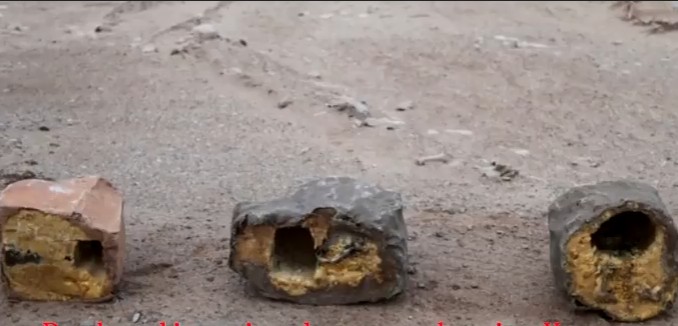A new report says roadside bombs disguised as rocks in Yemen bear similarities to others used by Iran’s terror proxy Hezbollah in southern Lebanon and by insurgents in Iraq and Bahrain, the Associated Press reported Monday.
The study by Conflict Armament Research comes as the West and United Nations researchers identified Iran as supplying arms to Yemen’s Houthis, a Shiite rebel group which has held the country’s capital since September 2014.
Those weapons allegedly included ballistic missiles used to target Saudi Arabia. On Sunday, Houthi rebels fired a barrage of seven ballistic missiles at the kingdom, killing one person and wounding two.
Iran has long denied supplying arms to the Houthis, but researchers claim they have found compelling evidence for Iranian involvement in the conflict.
“What we’re hoping this does is make plausible deniability not very plausible,” said Tim Michetti, head of regional operations for Conflict Armament Research. “You can’t really deny this anymore once the components these things are made with are traced to Iranian distributors.”
The independent watchdog said it examined a fiberglass-encased bomb, packed with explosives, and found a type of Chinese-manufactured wire covering used in other Iranian materiel. The experts observed that the “construction indicates that the bomb maker had a degree of knowledge in constructing devices that resembled, and possibly functioned in a manner similar to (explosively formed projectile bombs) that have been forensically tied to Iran and Hezbollah.”
The group further reported that drones used by the Houthi rebels to crash into Patriot missile batteries in Saudi Arabia share “near-identical design and construction characteristics” of Iranian drones.
This is not the first time Iran has been accused of arming the Houthis. The United States Navy’s 5th Fleet, based in Bahrain, has repeatedly said Iran sends arms into Yemen. From September 2015 through March 2016, they intercepted four Iranian smuggling vessels that yielded in total more 5000 AK-47 rifles, 80 antitank guided missiles as well as machine guns and sniper rifles, according to data released by the U.S. Navy.
The weapons transfers also include ballistic missile technology. The United Nations, Western countries and the Saudi-led coalition fighting in Yemen all say the Houthis’ Burkan or Volcano missile mirrors characteristics of an Iranian Qiam ballistic missile. The U.S., which provides support to the coalition, has also displayed in front of the U.N. what it said were Iranian-made weapons supplied to the Houthis by the Iranian regime, calling them conclusive evidence that Tehran was violating U.N. resolutions. A U.N. Panel of Experts concluded that Iran was in violation of U.N. Security Council Resolution 2216, which prohibits arms shipments to Yemen’s Houthi rebels.
In December 2016, Conflict Armament Research published another report in which it accused Iran of smuggling weapons to Houthi rebels. “This report provides evidence suggesting Iran is playing a hand in supplying weapons to the conflict in Yemen,” Jonah Leff, director of operations for the arms research group said at the time.
[Photo: Read for You / YouTube]




